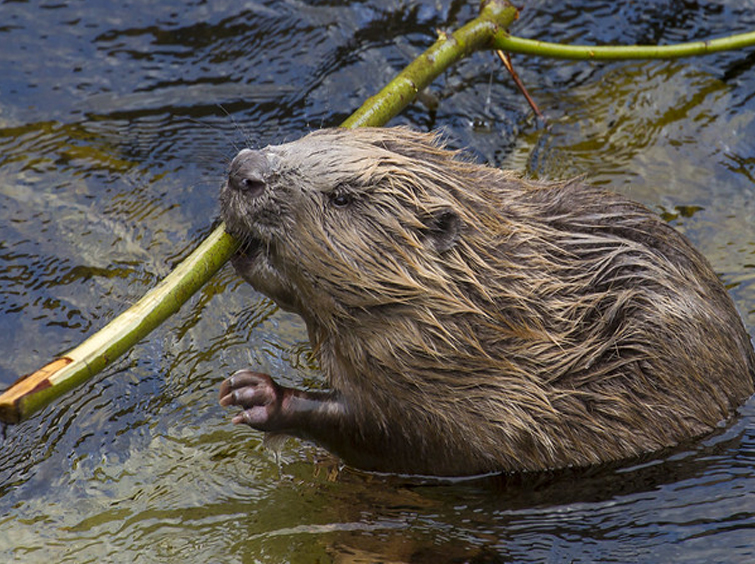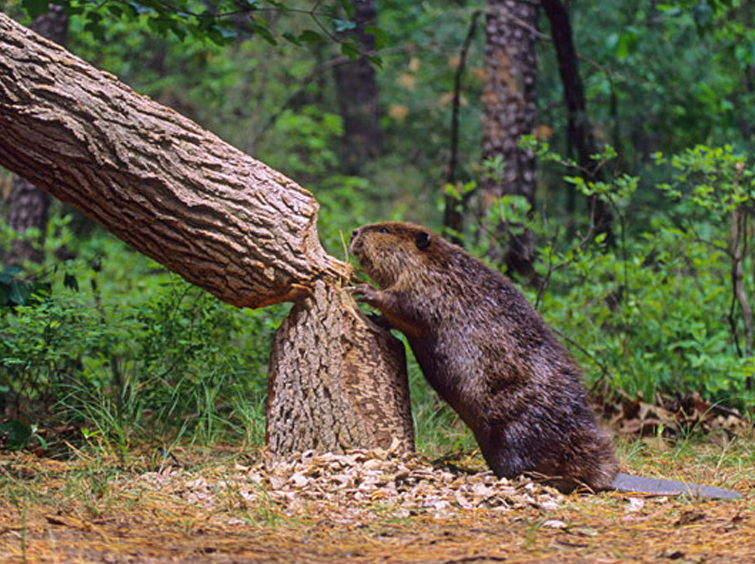TREES & PLANTINGS

BEAVERS DIET
Beavers often prefer to eat seaweed, clover and other land and aquatic plants, instead of the green bark (cambium) of trees, during warm weather. But, in areas with harsh winters, they need to prepare an underwater food cache of branches – unless abundant water lily tubers are available. They will normally use the peeled stick leftovers to build their dams and lodges. Because one beaver family (colony) often makes several of these teepee-shaped dwellings, the number of lodges is not a reliable way to estimate the number of local beavers.

TYPES OF TREES BEAVERS CUT
Beavers may fell a wide variety of trees, though they tend to cut fast-growing trees, such as poplar, willow, cottonwood and alder that have little commercial value. Although the felling of these trees may appear destructive, such culling often results in more, bushier growth next spring. For example, each willow stump may resprout three to four new stems, while poplars tend to regrow from their roots. If the beavers then use the branches from the old trees for a dam that creates a wetland, great benefits can result, such as water cleansing, erosion abatement, flood control, and more biodiversity.

PROTECTING TREES FROM BEAVERS
If you are concerned about protecting trees from beavers, consider that most cutting occurs within 50 feet of the shore. Although they may travel 200 feet from water, the likelihood of tree damage decreases as the distance from shore increases. While beavers prefer certain tree species, they do not necessarily take them in order of preference, so it’s a good idea to protect special ones. Leave the trees that are already down, so the beavers are not driven to cut more, while you are protecting others. In urban areas, tree trimming companies may drop off branches to provide alternative food. When planting trees along shorelines, consider the less palatable varieties, such as spruces in the eastern U.S. and cascara in the West.

CYLINDRICAL CAGES
Cylindrical cages are the best way to protect individual trees. Make them of sturdy 2 x 4 inch welded wire fencing, about four feet high (three feet is adequate in areas without snow). Encircle the trunk, leaving a space of about six inches between the tree and the fence. Cut every other horizontal wire to leave a long prong and bend these into hooks to attach with the other end. Cages should be anchored to the ground with stakes.
SPECIFIC INSTRUCTIONS:
- Making a cylinder with a diameter of 12 inches greater than the tree’s diameter will keep the fence the required 6 inches from the tree on all sides.
- To make the cylinder, cut the wire fence that comes 4-feet high to the length that you need and roll it into a cylinder.
- You can figure this out using the formula C = 0.318 x D; where C equals the circumference of the cylinder and D is the Diameter that you need, i.e. 12 inches greater than the tree diameter.
- Now to make a cylinder of this 4 ft. x C (as calculated above). You cut the horizontal wires on one side in order to attach to the other end once it’s wrapped around the tree. Cutting the horizontal wires before you wrap it around the tree makes it easier.
Chicken wire is less reliable, but this is sometimes used as a temporary measure, or to protect many small trees as with mitigation plantings. If this weaker fencing is used, stake rather close to the trunk to prevent crushing by beavers.


LOW FENCES
Low fences (3- or 4-feet high, depending upon the local snowfall) are used to protect groups of trees, and normally need not surround the entire stand, since beavers dislike being separated from the water. Have the fence fit tightly to the ground and trail each end toward the water.
Monitor often at the beginning for burrowing. If digging occurs, two concrete blocks tied together can be used to block the tunnel. If an electrified wire, such as those used for dog fences, is strung 4-6 inches off the ground, this serves the same purpose as a wire mesh fence.

PAINT WITH SAND
Coating tree trunks with a sand and paint mixture may prevent beaver gnawing as they dislike the gritty feel of sand in their mouths. Use 8 ounces of fine sand (30 mil, 70 mil or masonry sand) to one quart of oil or latex paint. Stir often and paint trunks about four feet high. The paint can be clear or color-coded to match the trees. Avoid painting young trees less than six feet tall as this may harm them.
Young, restoration trees can be protected with a combination of “4 the Birds,” or “Birds Away,” and sand. Apply the sticky substance with a dedicated brush that has also been dipped in sand, and painted a strip about four feet high on the trunks of saplings. Avoid using this method on older trees, which might be used by trunk climbing birds.

REPELLENTS AND OTHER METHODS
Repellents may protect saplings and foliage plants for a few months, but these work best when there’s other food available. Ro-pel is the only deterrent currently registered as a beaver deterrent with U.S. EPA. Research indicates that repellents containing sulfur compounds, such as Deer Off and Big Game Repellent Powder, are effective as temporary deterrents, but they are not yet registered for this use with EPA. Growing Season Repellent from Nott Products is reported to protect plants for up to two months, will not clog sprayers and can be used around edibles.
Occasionally beavers can be lured from a problem area to a new location. Methods used range from leaving otter, or dog, scat at the old site to spraying almond extract on willows to attract beavers and placing favorite foods (such as fresh poplar branches or apples) at the new site.
